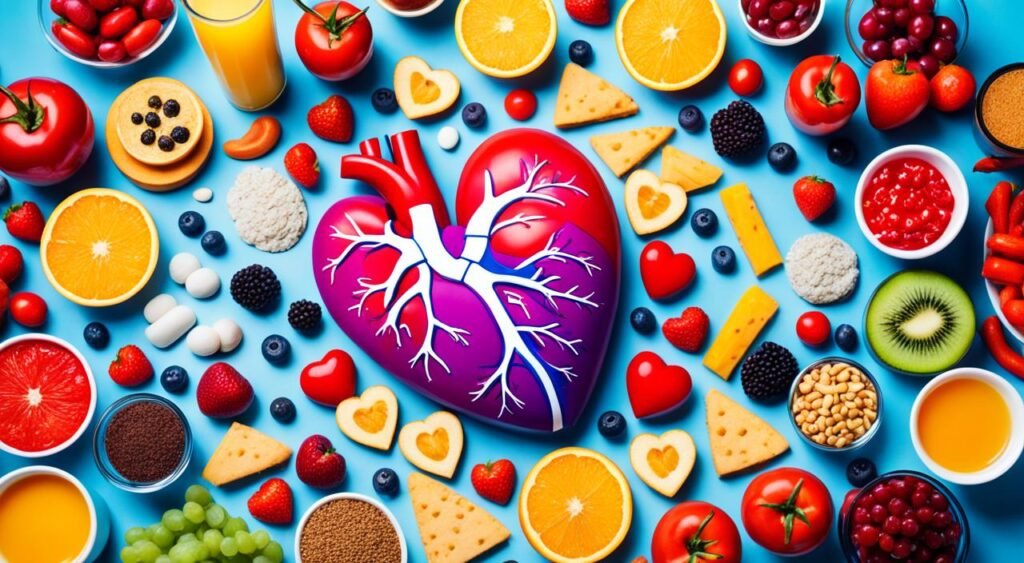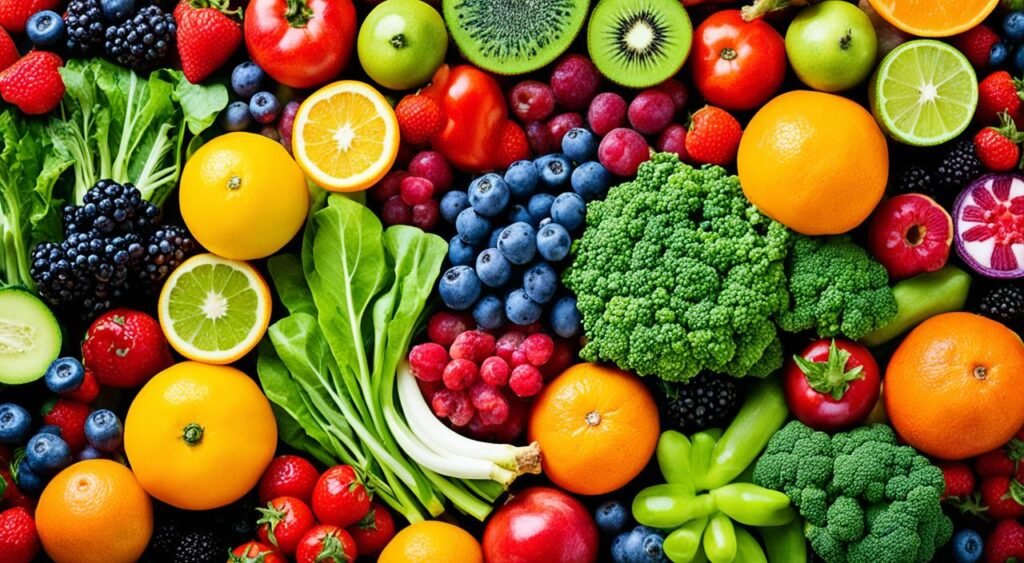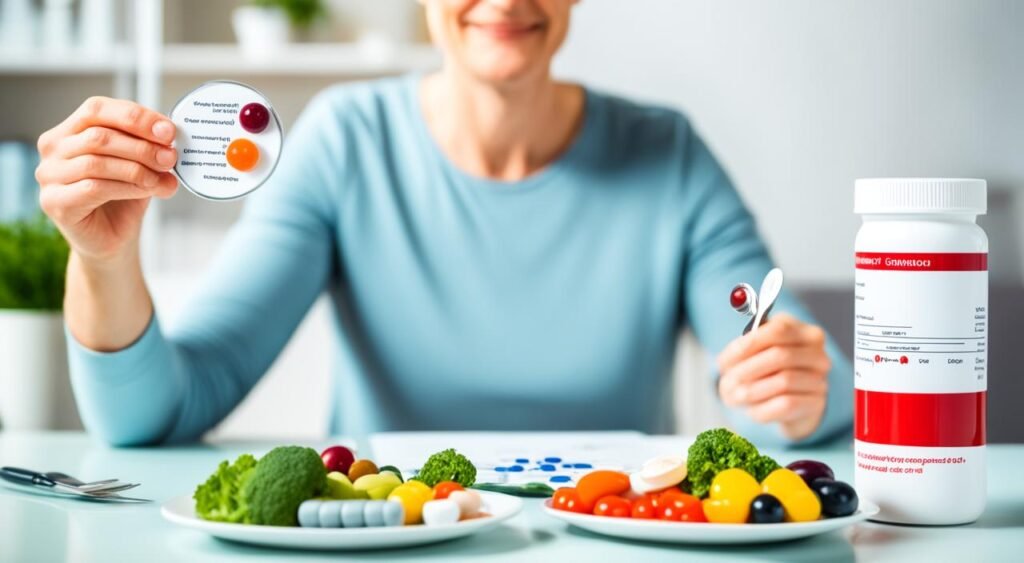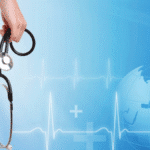Your diet is key in managing your blood pressure. High blood pressure is a big danger for heart disease and stroke. The food you eat affects your blood pressure a lot. A healthy eating style, like the DASH diet, really works in keeping blood pressure in check. It relies on eating less salt and more fruits, vegetables, whole grains, and low-fat dairy. Knowing how diet links to blood pressure lets you make smart food choices.
Key Takeaways
- Eating right is crucial for your blood pressure and hypertension control.
- Focusing on the DASH diet can help prevent and manage high blood pressure.
- Less sodium and more fruits, veggies, and low-fat dairy can lower blood pressure.
- Learning how your diet influences blood pressure means you can change for the better.
- A good diet, along with exercise and stress control, is great for managing blood pressure.
The DASH Diet: A Dietary Approach to Stop Hypertension
The DASH diet helps reduce high blood pressure. It is a heart-healthy eating plan. It includes nutritious foods and is low in sodium.
Also Read : How Do You Make A Frankie?
Principles of the DASH Diet
The DASH diet focuses on eating:
- Fruits, vegetables, and whole grains
- Low-fat or non-fat dairy
- Lean proteins like poultry, fish, and legumes
- It avoids too much sodium, saturated fat, and sugar
Also Read : What Are The Health Benefits Of Regular Exercise?
DASH Diet Food Groups and Serving Recommendations
The DASH diet gives serving sizes for each food group:
- Grains: 6-8 servings a day
- Fruits: 4-5 servings a day
- Vegetables: 4-5 servings daily
- Low-fat or non-fat dairy: 2-3 servings every day
- Lean proteins: 6 or fewer servings each day
- Nuts, seeds, legumes: 4-5 services weekly
- Fats and oils: 2-3 servings daily
Also Read : What Kinds Of Street Food Are There In USA ?
Tips for Following the DASH Diet
Here are tips for following the DASH diet:
- Go for low-sodium foods
- Cook with fresh ingredients at home
- Avoid processed, high-sodium foods
- Use herbs and spices for tasty, low-sodium meals
- Drink lots of water to stay hydrated
The DASH diet is proven to lower blood pressure. It is a great heart-healthy eating plan. By sticking to its principles, you can manage high blood pressure and take care of your heart health for the future.
Also Read : How Does Depression Impact Daily Life?
Sodium Intake and Blood Pressure Management
Keeping your blood pressure in check is key for a healthy heart. The amount of salt you eat matters a lot. Too much salt can cause high blood pressure. And guess what? Salt is not just in the shaker. It’s in a lot of foods we buy, often without us knowing.
Also Read : How Can Beginners Start Weightlifting Safely?
Sources of Hidden Sodium in the Diet
Hidden salt shows up in many foods we eat every day, such as:
- Breads and cereals
- Canned soups and vegetables
- Frozen meals and entrees
- Condiments, sauces, and dressings
- Processed meats like deli cuts, sausages, and bacon
Even foods that seem low in salt might not be. This is because of how they are made. Being careful about what you eat and reading labels is a smart move. Try to pick foods that have less salt or are salt-free.
Strategies for Reducing Sodium Consumption
Ways to cut back on salt and better your heart health include:
- Pay close attention to food labels. Choose items with less salt.
- Avoid too many processed, canned, and restaurant meals. They’re often packed with salt.
- Cooking at home with fresh, natural ingredients can help. Use herbs, spices, and a splash of lemon rather than salt.
- Drain and rinse canned foods like beans to lower their salt content.
- Pick low-sodium or salt-free varieties of cooking basics such as broth, ketchup, and salad dressings.
Being smart about the salt you eat is a big deal. These steps can help you keep your blood pressure healthy and support your heart.
Blood Pressure and Heart Health

Keeping your blood pressure at a healthy level is key for good cardiovascular health. If it’s too high, known as hypertension, you boost the chance of getting heart diseases. These can be heart attack, stroke, or heart failure. Your heart and blood vessels can get seriously damaged from high blood pressure.
But, if you manage to keep your blood pressure low, you cut down on these threats to your heart. To do this, stick to a healthy lifestyle. This means eating well, exercising, and learning how to deal with stress. It’s all about balancing things to protect your heart health.
The Link Between High Blood Pressure and Heart Disease
High blood pressure makes the heart pump harder. This can make a part of the heart muscle get thicker and stiffer, which is dangerous. It’s called left ventricular hypertrophy.
This makes the risk of heart attack, heart failure, and even sudden cardiac death go up. Moreover, high blood pressure can harm your blood vessels. They might start to gather plaque and become inflamed. This bad process is called atherosclerosis. It makes your arteries narrower, raising the odds of having a stroke or peripheral artery disease.
“Controlling high blood pressure is one of the most important things you can do to reduce your risk of heart disease and stroke.”
By controlling your blood pressure, you’re doing a lot for your heart’s health. This simple step lowers the risk of many heart problems. It’s a great way to stay healthy.
Lifestyle Factors Affecting Blood Pressure
Your diet is key in keeping your blood pressure in check. But, keeping active and managing stress are just as important. These things help keep your blood pressure at healthy levels.
Role of Exercise and Physical Activity
Regular exercise benefits your blood pressure. Activities like walking, cycling, or swimming make your heart stronger. They also help your heart work more efficiently. Adding these physical activity types to your life can do a lot for your health.
Stress Management and Blood Pressure
Chronic stress can make hypertension worse. Stress releases hormones that raise your blood pressure. That’s why learning to manage stress is vital. Techniques like meditation and deep breathing can lower your blood pressure. This supports a healthier heart.
“Incorporating regular physical activity and effective stress management into your lifestyle can be powerful tools in the fight against high blood pressure.”
It’s important to tackle both body and mind to keep your blood pressure healthy. This way, you lower the risks of health problems down the line.
Understanding Hypertension and Its Risks

Hypertension is often called high blood pressure. It’s a widespread, serious health issue. This condition can lead to major health problems. There are two kinds: primary and secondary.
Types of Hypertension
Primary hypertension doesn’t have a clear cause. It’s the most typical type, affecting 90-95% of those with high blood pressure. It’s linked to genetics, lifestyle choices, and the environment. On the flip side, secondary hypertension is due to other health issues, like kidney disease or hormone problems.
Complications of Uncontrolled High Blood Pressure
High blood pressure that’s not managed well can cause serious health issues. These include:
- Heart attack: High blood pressure can damage the heart, leading to heart attacks.
- Stroke: It can make arteries hard and narrow, raising the chance of a stroke.
- Kidney disease: The extra strain can harm the kidneys, possibly leading to failure.
- Vision problems: It can hurt blood vessels in the eyes, causing vision loss.
It’s vital to know about the types of high blood pressure and the risks of not treating it. Watching your blood pressure, changing your lifestyle, and sometimes taking medicine are key. These steps can lower your risk of serious health issues.
Monitoring and Measuring Blood Pressure
It’s very important to keep an eye on your blood pressure. This helps in dealing with high blood pressure and keeps your heart healthy. Doctors use a sphygmomanometer to check your blood pressure. It has an arm cuff. This tool tells them about your systolic and diastolic pressures. Systolic is when your heart is beating, and diastolic is when it’s at rest.
Home Blood Pressure Monitoring
Monitoring your blood pressure at home has many benefits. It lets you check your pressure often and show your doctor the results. This way, any issues can be noticed early, helping in treating high blood pressure.
Here are a few pros of checking blood pressure at home:
- It helps you know your blood pressure levels well.
- It catches any changes in your blood pressure early.
- It makes talking to your doctor easier.
- It helps in managing high blood pressure and choosing the right treatment.
But, there are certain steps you must follow for accurate results. Use a well-tested blood pressure monitor. Sit quietly for about 5-10 minutes before measuring it. Also, take several measurements to get a reliable average.
| Measurement | Optimal | Elevated | Hypertension |
|---|---|---|---|
| Systolic (top number) | Less than 120 mmHg | 120-129 mmHg | 130 mmHg or higher |
| Diastolic (bottom number) | Less than 80 mmHg | 80-84 mmHg | 85 mmHg or higher |
Keeping a close watch on your blood pressure is good for your heart. It helps lower the risks that come with high blood pressure. Working together with your doctor is key to staying healthy.
Dietary Guidelines for Maintaining Healthy Blood Pressure

To keep your blood pressure in check, focus on eating nutrient-rich foods. The DASH diet helps a lot with this, offering a great eating plan. Here’s what you should include in your meals:
- Put lots of fruits, veggies, whole grains, low-fat dairy, lean proteins, and healthy fats on your plate.
- Try to eat less sodium, saturated fat, and added sugars to avoid high blood pressure.
- Eat foods high in potassium, like bananas, sweet potatoes, and leafy greens. They balance out sodium’s effects.
- Go for foods rich in fiber, magnesium, and calcium. They help keep your blood pressure at normal levels.
Nutrient-Rich Foods for Blood Pressure Control
Include plenty of nutrient-dense foods in your diet to manage your blood pressure well. Opt for these heart-healthy choices:
| Food | Key Nutrients | Potential Benefits |
|---|---|---|
| Salmon | Omega-3 fatty acids, protein | Reduce inflammation and improve blood vessel function |
| Spinach | Magnesium, potassium, nitrates | Support blood pressure regulation and improve blood flow |
| Blueberries | Antioxidants, flavonoids | Improve blood vessel function and reduce inflammation |
| Lentils | Fiber, magnesium, potassium | Promote healthy blood pressure levels and support heart health |
| Avocado | Monounsaturated fats, potassium | Help lower blood pressure and improve cholesterol levels |
By sticking to these dietary rules and adding nourishing foods to your diet, you’ll keep your blood pressure in line. This will also help your heart stay healthy.
Also Read : Explore The Best Of Liberty Health Sciences Today
Integrating Diet with Medication

If you have hypertension, changing your diet is an important step. But, sometimes, diet isn’t enough. Doctors might add blood pressure medication to your treatment plan. It’s key to work closely with your healthcare team. This ensures your approach to treatment meets your unique needs.
For controlling hypertension, the DASH diet is a good choice. It works well with blood pressure medications to keep your blood pressure in check. This combined approach helps you manage high blood pressure and lowers the danger of heart issues.
Combining Diet and Medication
When you’re managing hypertension with diet and medication, follow some rules:
- Set up a treatment plan with your healthcare provider. Make sure it matches your dietary changes with the right blood pressure medications.
- Always take your medications as told and watch out for any side effects.
- Eat a healthful, balanced diet like the DASH diet to keep your heart in good shape.
- Exercise regularly and find ways to beat stress to help your heart.
- Check your blood pressure often to see how well your plan is working.
This full method of managing hypertension helps you keep your blood pressure under control. It reduces the threats of serious health complications.
| Medication | Dietary Considerations |
|---|---|
| Diuretics | Eat more potassium-rich foods and drink enough water to avoid dehydration. |
| ACE Inhibitors | Cut back on salt to prevent side effects. |
| Angiotensin II Receptor Blockers (ARBs) | Eat a heart-healthy diet to keep your cardiovascular system strong. |
| Calcium Channel Blockers | Avoid grapefruit and its juice, because it can clash with some meds. |
Working closely with your healthcare team, you can blend a healthy diet with your blood pressure medication. This way, you can effectively manage hypertension for better health.
Conclusion
In conclusion, blood pressure control is a key part of staying heart-healthy. The DASH diet shows how eating certain foods can help. It focuses on eating less salt and more nutrient-rich meals. Besides good eating, staying active and managing stress helps to keep blood pressure in check.
It’s vital to see how our diet, lifestyle, and blood pressure are linked. We can make changes to better our heart health and avoid health risks. A mix of good food, regular exercise, and maybe medicine can do a lot for our blood pressure and heart health.
By adjusting our food and lifestyle, we can impact our blood pressure. This approach can lower the risks linked to high blood pressure. Eating well, moving often, and handling stress are all key. This way, we support our heart for a healthier life in the long run.
FAQs
What role does diet play in controlling blood pressure?
What are the key principles of the DASH diet?
How can I reduce my sodium intake to manage blood pressure?
How does high blood pressure affect heart health?
What lifestyle factors can impact blood pressure?
What are the different types of hypertension?
How can I effectively monitor my blood pressure?
What dietary guidelines should I follow to maintain healthy blood pressure?
How can I integrate diet with medication for managing hypertension?
Source Links
- https://www.mayoclinic.org/healthy-lifestyle/nutrition-and-healthy-eating/in-depth/dash-diet/art-20048456
- https://pubmed.ncbi.nlm.nih.gov/20645853/
- https://www.heart.org/en/health-topics/high-blood-pressure/changes-you-can-make-to-manage-high-blood-pressure/managing-blood-pressure-with-a-heart-healthy-diet





